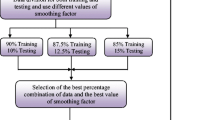Abstract
Infrastructure asset management provides a framework to handle both short-and long-term planning for the maintenance and rehabilitation of infrastructure. In this study, as major demand forecasting methodologies, artificial neural networks (ANNs) and multiple regression methodologies have been reviewed. For sewer demand forecasting, two forecasting models, artificial neural networks and multiple regression models, were developed and their results were compared. Research findings indicated that the multiple regression model has the ability to explain the relationship between the predictor variables, while the ANN model better represents the non-forecasting allows asset managers to predict the future sewer demand, thus asset managers can identify “critical” sewers (i.e., current hydraulic capacity not meeting the future demand) by comparing the current hydraulic capacity with the future demand. Identifying and rehabilitating “critical” sewers before any major failure occur can prevent health and environmental hazards and lead to cost savings.
Similar content being viewed by others
References
Akintoye, A. and Skitmore, M. (1994). “Models of UK Private Sector Quarterly Construction Demand.”Construction Management and Economics, E. & F.N. Spon, London, England, Vol. 12, pp. 3–13.
ASCE (1982). “Gravity Sanitary Sewer Design and Construction.” American Society of Civil Engineers—Manuals and Reports on Engineering Practice—No.60. Water Pollution Control Federation—NO. FD-5. New York, New York. U.S.
Chung, S. (2001). “Demand Modeling and Analysis for the Management of Underground Infrastructure Systems.”Ph. D. Dissertation, School of Civil Engineering, Purduc University, West Lafayette, Indiana. U.S.
Federal Highway Administration, Office of Asset Management, U.S. Department of Transportation. (1999).Asset Management Primer, Washington, D.C., U.S.
Federal Highway Administration and the American Association of State Highway and Transportation Officials (1996).Asset Management: Advancing the State of the Art Into the 21st Century Through Public-Private Dialogue, Washington, D.C., U.S. p.3.
Garvin, M. (2001). “Challenges of Infrastructure Asset Management.”First Annual Conference on Infrastructure Priorities, Washington, D.C. Oct. 24–26, U.S.
Gujarati, D.N. (1995).Basic Econometrics. McGraw Hill, New York.
Hua, G.B. (1996). “Residential Construction Demand Forecasting Using Economic Indicators: A Comparative Study of Artificial Neural Networks and Multiple Regression.”Construction Management and Economics, E. & F.N. Spon, London, England, Vol. 14, pp. 25–34.
Khotanzad, A., Afkhami-Rohani, R., Lu, T., Abaye, A., Davis, M., and Maratukulam, D.J. (1997). “ANNSTLF— A Neural-Network-Based Electric Load Forecasting System.”IEEE Transactions on Neural Networks, Vol. 8, No. 4, pp. 835–845.
Koo, S. (2002). Sinking 50 billion won into the ground, Daily Chosun, Seoul, Korea.
Lee, S. and Chung, S. (2003). “Infrastructure Asset Management— Methodologies for Infrastructure Asset Management System in U.S.”CMitization in Construction, 2003 KICEM Conference, Korea, pp. 67–72.
Liong, S., Lim, W., and Paudyal, G.N. (2000). “River Stage Forecasting in Bangladesh: Neural Network Approach.”Journal of Computing in Civil Engineering, ASCE, Vol. 14, No. 1, pp. 1–8.
Malik, O., Pumphrey, N.D., and Roberts, F.L. (1997). “Sanitary Sewers: State-of—the Art Practice.”Proceedings of the Conference on Infrastructure Condition Assessment: Art, Science, and Practice. Facilities Management Committee of the Urban Transportation Division of the American Society of Civil Engineers, Minneapolis, Minnesota. U.S.
Neter, J., Kutner, M.H., Nachtsheim, C.J., and Wasserman, W. (1996).Applied Linear Statistical Models, Fourth Edition, Richard D. Irwin, Inc., Chicago, IL. U.S.
Tsoukalas, L. H. and Uhring, R. E. (1997).Fuzzy and Neural Approaches in Engineering. John Wiley & Sons, Inc., New York, NY.U.S.
Weber, J.A. (1993). “Integrating Conservation Targets into Water Demand Projections.”Journal of American Water Works Association, Vol. 85, No. 8, pp. 63–70.
WEF-ASCE (1994).Existing Sewer Evaluation and Rehabilitation. ASCE Manuals and Reports on Engineering Practice, No. 62, Alexandria, Virginia. U.S.
Yaffee, R.A. (2000).Introduction to Time Series Analysis and Forecasting with Applications of SAS and SPSS. Academic Press, Inc., San Diego, CA. U.S.
Author information
Authors and Affiliations
Rights and permissions
About this article
Cite this article
Lee, SY., Chung, SK. & Oh, JK. Demand forecasting based infrastructure asset management. KSCE J Civ Eng 8, 165–172 (2004). https://doi.org/10.1007/BF02829116
Received:
Accepted:
Issue Date:
DOI: https://doi.org/10.1007/BF02829116




